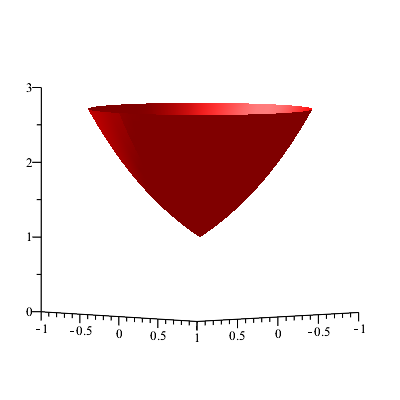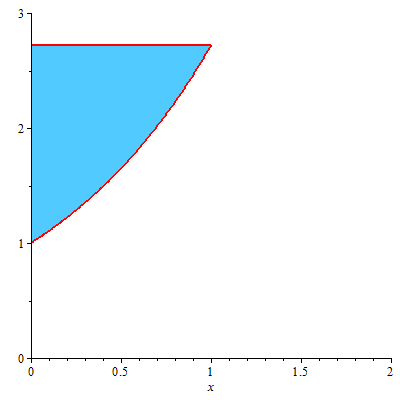Disc Method. In this solution, we consider the volume as a sum of slices, cut orthogonal to the  -axis. Each slice has volume
-axis. Each slice has volume  , where
, where  is its radius and
is its radius and  is its thickness. The bowl will be made by rotating the shaded blue region in the 2D figure
is its thickness. The bowl will be made by rotating the shaded blue region in the 2D figure
. If the slice is at height  , then its radius is equal to
, then its radius is equal to  , where
, where  . Hence,
. Hence,  In the limit
In the limit 

Note that the limits of integration are  and
and  since
since  ranges from 0 to 1.
ranges from 0 to 1.
We use integration by parts to evaluate this integral, letting  So in order to perform the integration by parts we need to recall the antiderivative of
So in order to perform the integration by parts we need to recall the antiderivative of  . To calculate this antiderivative we again use integration by parts:
. To calculate this antiderivative we again use integration by parts:

We now use this antiderivative to perform the integration by parts in the integral for  Hence,
Hence,
![{\displaystyle {\begin{aligned}V_{2}&=\pi \int _{1}^{e}(\ln y)^{2}\,dy\\&=\pi \left[\ln y(y\ln y-y)\right]_{1}^{e}-\pi \int _{1}^{e}{\frac {1}{y}}(y\ln y-y)\,dy\\&=\pi \left[1(e\cdot 1-e)-0\right]-\pi \int _{1}^{e}(\ln y-1)\,dy\\&=-\pi \left[y\ln y-y-y\right]_{1}^{e}\\&=-\pi \left[e\ln e-e-e-1\ln 1+1+1\right]\\&=-\pi \left(-e+2\right)\\&=\pi \left(e-2\right).\\\end{aligned}}}](https://wiki.ubc.ca/api/rest_v1/media/math/render/svg/198b19d32d9489bbd57f7b1a1fd7ed5d1298080c)
Reality check: Note that we obtain the same value for  with both methods. To visualize the full bowl we can look at the 3D figure
with both methods. To visualize the full bowl we can look at the 3D figure

Full 3D image from rotation
.
















![{\displaystyle {\begin{aligned}V_{2}&=\pi \int _{1}^{e}(\ln y)^{2}\,dy\\&=\pi \left[\ln y(y\ln y-y)\right]_{1}^{e}-\pi \int _{1}^{e}{\frac {1}{y}}(y\ln y-y)\,dy\\&=\pi \left[1(e\cdot 1-e)-0\right]-\pi \int _{1}^{e}(\ln y-1)\,dy\\&=-\pi \left[y\ln y-y-y\right]_{1}^{e}\\&=-\pi \left[e\ln e-e-e-1\ln 1+1+1\right]\\&=-\pi \left(-e+2\right)\\&=\pi \left(e-2\right).\\\end{aligned}}}](https://wiki.ubc.ca/api/rest_v1/media/math/render/svg/198b19d32d9489bbd57f7b1a1fd7ed5d1298080c)

